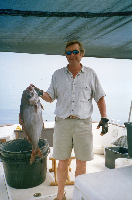Imperial blackfish
| Imperial blackfish | |
|---|---|

| |
| Scientific classification | |
| Domain: | Eukaryota |
| Kingdom: | Animalia |
| Phylum: | Chordata |
| Class: | Actinopterygii |
| Order: | Scombriformes |
| Family: | Centrolophidae |
| Genus: | Schedophilus |
| Species: | S. ovalis
|
| Binomial name | |
| Schedophilus ovalis (G. Cuvier, 1833)
| |
| Synonyms | |
| |
The imperial blackfish, Schedophilus ovalis, is a medusafish of the family Centrolophidae found in the eastern Atlantic and the Mediterranean Sea, and occasionally western Atlantic (Bermuda). It occurs at depths of between 70 and 700 m.[1] In its juvenile stage it is often found finding shelter amongst of the tentacles of floating jellyfish, including the Portuguese man o' war.[1][2] It grows to 100 cm (39 in) total length.[1]
References
- ^ a b c Froese, Rainer; Pauly, Daniel (eds.) (2019). "Schedophilus ovalis" in FishBase. December 2019 version.
- ^ Honeyborne, James & Mark Brownlow (2017). Blue Planet II. Ebury Publishing. p. 293. ISBN 978-1-4735-3007-2.
